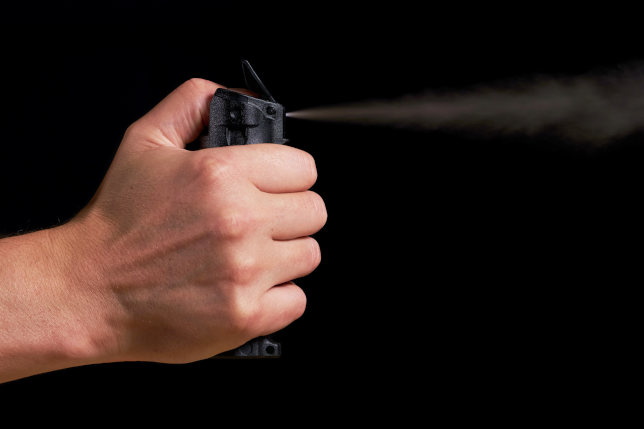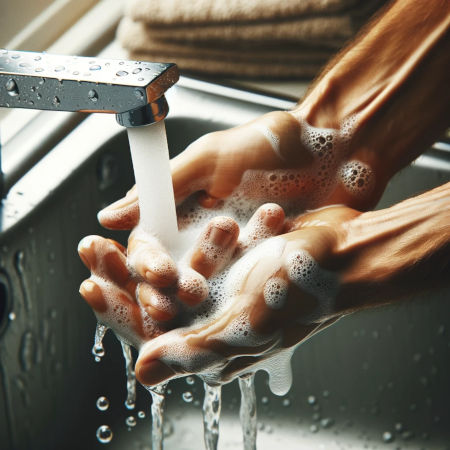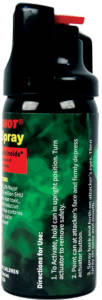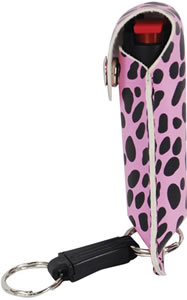How Does Pepper Spray Work?

How Does Pepper Spray Work?
Pepper spray is one of the most effective and widely used non-lethal self-defense tools. Whether carried for personal protection or used by law enforcement, its powerful formula quickly incapacitates attackers by causing intense burning, temporary blindness, and difficulty breathing. But what exactly is pepper spray made of, and how does it work?
Looking for the best pepper spray for self-defense? Browse our top-rated options here!
What Is Pepper Spray Made Of?
The active ingredient in pepper spray is oleoresin capsicum (OC), a concentrated extract derived from chili peppers. The primary compound responsible for its burning effect is capsaicin, the same substance that makes hot peppers spicy. When sprayed, this compound irritates the eyes, skin, and respiratory system, causing an immediate and intense reaction.
Pepper spray is typically mixed with aerosol propellants (like nitrogen or CO2) that allow it to disperse effectively. Some formulations also include UV dye to mark an assailant for later identification or tear gas (CS or CN) for additional incapacitating effects.
How Pepper Spray Works on Attackers
When deployed, pepper spray creates an immediate inflammatory response, resulting in:
-
Eye irritation & temporary blindness – Causes severe burning, excessive tearing, and involuntary eye closure.
-
Respiratory distress – Induces coughing, shortness of breath, and throat constriction.
-
Skin burning & irritation – Feels like an intense sunburn on exposed areas.
The effects typically last between 20-60 minutes, giving you enough time to escape and seek help. Unlike tear gas, which affects pain receptors, pepper spray directly inflames tissues, making it highly effective even against individuals under the influence of drugs or alcohol.
Types of Pepper Spray Formulations
Pepper spray is available in different spray patterns, each suited for different situations:
-
Stream – Shoots a concentrated stream for precise targeting with less risk of blowback.
-
Mist – Covers a wider area but is more susceptible to wind.
-
Fog – Creates a cloud-like dispersion, ideal for crowd control.
-
Gel – Sticks to an attacker’s skin, reducing airborne exposure.
Most sprays have a range of 6-12 feet, allowing you to maintain a safe distance from threats.
How Strong Is Pepper Spray?
Pepper spray strength is measured in Scoville Heat Units (SHU), the same scale used for chili peppers:
-
Jalapeño Pepper – 2,500-8,000 SHU
-
Habanero Pepper – 200,000-350,000 SHU
-
Carolina Reaper – 1.5+ million SHU
-
Pepper Spray – 500,000 to 5.3 million SHU
High-SHU sprays provide greater stopping power, making them highly effective against aggressive threats.
Safety Tips for Using Pepper Spray
To ensure effective and responsible use: ✅ Aim for the face, especially the eyes and nose. ✅ Use short bursts to conserve spray and prevent self-exposure. ✅ Move away immediately after spraying. ✅ Check local laws before carrying pepper spray. ✅ Practice with an inert canister to familiarize yourself with deployment.
Final Thoughts
Understanding how pepper spray works and what it’s made of can help you choose the right formula for your safety needs. Whether for personal protection or professional use, pepper spray remains one of the most effective self-defense tools available.
Stay safe, stay prepared – Browse our top-rated pepper sprays today!
Frequently Asked Questions About Pepper Spray
How long do the effects of pepper spray last?
The effects typically last 20 to 60 minutes, though burning and irritation may persist longer depending on the individual's sensitivity and exposure. The initial impact is intense, but symptoms gradually subside. For tips on reducing the discomfort, rinse with cold water, mild soap, or a saline solution—avoid rubbing the affected areas.
How long does pepper spray stay potent in the canister?
Most pepper spray canisters last 2 to 4 years before losing pressure or potency. Check your expiration date, and replace it as needed. For a full breakdown of pepper spray shelf life and storage tips, read our guide here.
Does pepper spray work on animals?
Yes, pepper spray is effective against aggressive animals like dogs and bears. However, bear spray is specifically formulated for larger animals, offering a wider dispersal pattern and higher volume. If you're considering protection against wildlife, bear spray may be the better choice.
What neutralizes pepper spray?
To quickly relieve the burning effects of pepper spray, avoid rubbing the affected area and use cold water, mild soap, or a saline solution. Some people find relief using milk or baby shampoo, but effectiveness varies. For a full guide on removing pepper spray from skin, read our step-by-step removal guide here.

Is pepper spray legal everywhere?
Pepper spray laws vary by state and country, with some places restricting size, concentration, or use. Some states prohibit pepper spray for minors or require a permit. Always check local laws before purchasing or carrying pepper spray.
What’s the difference between pepper spray and Mace?
Mace is a brand name, while pepper spray is a general term for self-defense sprays containing oleoresin capsicum (OC). Some Mace products combine OC with tear gas (CS or CN) for additional effects, making them different from standard pepper spray formulations.
Add your comment now!
Post CommentRecent posts
-
03/12/2025Best Stun Guns for Self-Defense in 2025
-
03/11/2025How to Prevent Kidnapping – Top Safety Tips
-
03/11/2025What Do Rapists Look For? 10 Red Flags to Avoid


